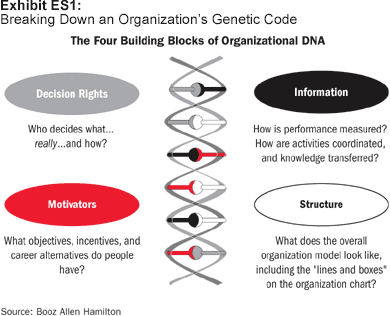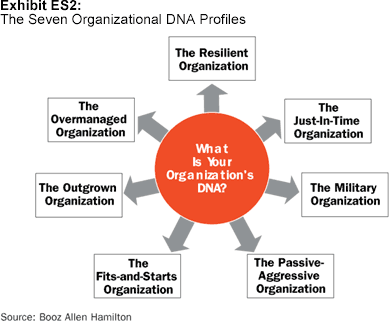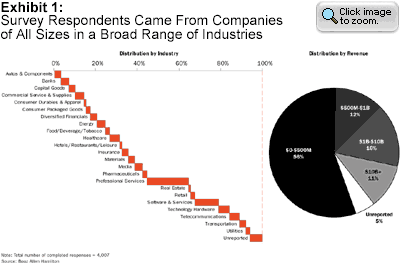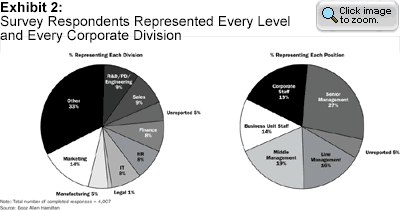Profiles in Organizational DNA Research and Remedies
(originally published by Booz & Company)
|
“Execution” has become the new watchword in board rooms around the globe, as CEOs and directors watch sound strategies fail at the hands of organizations that cannot or will not effectively implement them. The ability to execute is not something you can recruit or mandate. It is inherent—embedded in the management processes, relationships, measurements, and beliefs that constitute an organization’s DNA. Like the DNA of living organisms, the DNA of living organizations consists of four building blocks, which combine and recombine to express distinct identities, or personalities. These organizational building blocks—decision rights, information, motivators, and structure—largely determine how a firm looks and behaves, internally and externally. Unlike humans and other organisms, however, organizations have the ability to change their DNA by adjusting and adapting these building blocks.
The Org DNA Profiler™
Using a short, online self-assessment tool called the Org DNA Profiler™ (www.orgdna.com), employees at all levels can now identify their organization’s DNA type (e.g., Resilient, Just-in-Time, Military, Passive-Aggressive, Fits-and-Starts, Outgrown, Overmanaged) and diagnose the root causes of value-destroying traits and behaviors, a first step in improving execution effectiveness and financial performance. The organizational DNA framework helps companies identify and expose hidden strengths and entrenched weaknesses…so that managers can focus efforts on reinforcing what works in their organization and modifying what does not. (With that in mind, we have referenced various readings throughout this article that can help managers trace the root causes of dysfunction in their organization and remedy what is not working.)
Similar in nature to familiar individual personality assessments, the Org DNA Profiler™ assessment tool categorizes organizational character based on employees’ responses to a five-minute survey composed of 19 questions. This assessment tool, while based on individuals’ survey responses, focuses on the traits and behaviors of the organization as a whole rather than on the individuals who populate it, although certain general demographic data (e.g., position/level, division, industry, annual revenue) are collected to enhance the analysis.
Each survey question addresses organizational behavior with regard to one of the four building blocks of organizational DNA: decision rights, information, motivators, and structure. The 19 responses are then fed through proprietary software that assigns the organization described to one of seven organizational profiles developed by Booz Allen consultants based on years of working with companies to diagnose and overcome organizational impediments to effective execution. The seven profiles are described below:
The Resilient Organization. This organization is flexible enough to adapt quickly to external market shifts, yet it remains steadfastly focused on and aligned around a coherent business strategy. This forward-looking organization anticipates changes routinely and addresses them proactively. It attracts motivated team players and offers them not only a stimulating work environment, but also the resources and authority necessary to solve tough problems effectively.
The Just-in-Time Organization. Although not always proactive in preparing for impending changes, this organization has demonstrated an ability to “turn on a dime” when necessary, without losing sight of the big picture. Although it manages to hold onto good people and performs well financially, it has not managed to bridge the gap between good and great. This organization tends to miss opportunities by inches rather than miles, and to celebrate successes that are marginal rather than unequivocal. Despite its frustrations, however, it can still be a stimulating and challenging place to work.
The Military Organization. Often driven by a small, hands-on senior management team, this organization succeeds through sheer force of will...that of its top executives. It can conceive and execute brilliant strategies—sometimes repeatedly—but its middle management bench can be shallow and short lived. This organization’s biggest liability is preparing for growth beyond the tenure of its current leaders. Junior talent in this organization typically learns by seeing rather than doing, and middle management often defects as up-and-comers realize they must leave the nest to get flying experience.
The Passive-Aggressive Organization. So congenial that it seems conflict free, this is the “everyone agrees but nothing changes” organization. Building a consensus to make major changes is no problem; implementing them is what proves difficult. Entrenched, underground resistance from the field can defeat Corporate’s best efforts. Lacking the requisite authority, information, and incentives to undertake meaningful change, line employees tend to ignore mandates from headquarters, assuming “this too shall pass.” Confronted with an apathetic organization, senior management laments the futility of “pushing Jell-O.”
The Fits-and-Starts Organization. Scores of smart, motivated, and talented people populate this organization, but they do not often pull in the same direction at the same time. When they do, they can execute brilliant, breakout strategic moves, but the organization typically lacks the discipline and coordination to repeat these successes on a consistent basis. It is an environment that lures intellect and initiative—those people with an entrepreneurial bent—because the opportunities to pursue an idea and exercise responsibility are abundant. The result, however, can be an organization with a disjointed self-image on the verge of spinning out of control.
The Outgrown Organization. This firm has outgrown its organizational model; it is bursting at the seams. Too large and complex to be effectively controlled anymore by a small team of top executives, it has yet to “democratize” decision-making authority. Consequently, much of the organization’s potential remains untapped. By keeping power centralized, the organization tends to move slowly and often finds it cannot get out of its own way. Such firms routinely miss opportunities and consistently fail to execute effectively.
The Overmanaged Organization. Burdened with multiple layers of management, this organization tends to suffer from “analysis paralysis.” When it does move, it moves slowly and reactively, often pursuing opportunities later or less vigorously than its competitors. More consumed with the trees than the forest, managers spend their time checking one another’s work rather than scanning the horizon for new opportunities or threats. These organizations, which are frequently bureaucratic and highly political in nature, tend to frustrate self-starters and results-oriented individuals.
Booz Allen launched the Org DNA Profiler™ assessment tool (www.orgdna.com) on December 9, 2003, and collected 4,007 completed profiles in the first two weeks. Respondents came from companies of all sizes across a wide range of industries from financial services and automakers to consumer packaged goods (see Exhibit 1). Moreover, respondents represented every level in the corporate hierarchy and every division (see Exhibit 2). This report marks the first summary look at the results to date; key findings are featured below.
1. Most Organizations Are Unhealthy
Of the seven organizational profiles, only three—Resilient, Just-in-Time, and Military—can be described as relatively free from dysfunction, or “healthy.” As Exhibit 3 shows, only 27% of the survey responses resulted in one of those three healthy profiles, and more than 60% of respondents indicated that the traits and behaviors of their organizations were “unhealthy” in some way. Their responses described firms unable to act decisively or effectively.
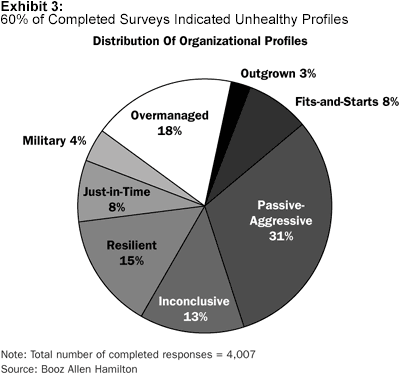
Passive-Aggressive was the most prevalent organizational type, with 31% of respondents reporting organizational behaviors consistent with that profile. Overmanaged was the second largest category, at 18%. Only 15% of respondents gave answers resulting in very healthy, or Resilient, profiles.
2. Organizational DNA Changes as Companies Grow
The 4,000-plus completed surveys collectively suggest a four-step company growth story (see Exhibit 4). As companies grow, they may migrate through certain profile types as they evolve, hitting rough patches when their DNA lags behind. Note that DNA clearly does evolve in organizations as they adapt to changes in culture and the competitive environment. Astute managers appreciate these subtle shifts and can help their organizations successfully transition to new models as the company expands.
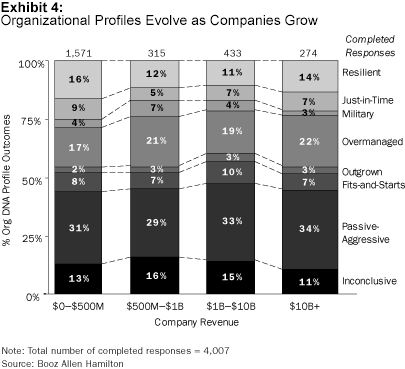
Step 1: $0–$500 Million. Responses from small companies are most likely to result in Resilient or Just-in-Time profiles. These profiles describe organizations that are effective at executing and adapting to change in their environment.
This finding is intuitive because small companies tend to be younger and therefore may be more attuned to and aligned behind the vision and strategy of the founder. Moreover, their small size allows them to adapt more quickly and nimbly to external market shifts.
Step 2: $500 Million–$1 Billion. As firms cross the $500-million threshold, many seem to address their growing coordination challenges by centralizing authority in a strong senior team that drives the business. Not surprisingly, the Military profile peaks in this revenue segment. In addition, we see a sharp increase in Overmanaged profiles, suggesting that many firms in this size range become bureaucratic, slow, and overly politicized as growing middle management starts to second-guess and interfere in lower-level decisionmaking.
Step 3: $1 Billion–$10 Billion. Once past the $1-billion threshold, organizations become too large and complex to be run effectively by a small, senior team via command-and-control mechanisms. Companies are thus forced to decentralize.
Given the marked increase in Fits-and-Starts profiles in the $1 billion–$10 billion revenue range, the transition to a decentralized organizational model appears to go badly in many cases. Local managers may be given the authority to make decisions, but not the incentives or information to make them well.
Passive-Aggressive profiles also increase in this range, because incoherent and uncoordinated structures and processes create inertia, confusion, and ultimately a failure to execute.
Step 4: >$10 Billion. To survive and grow to this size, companies have clearly had to figure out how to execute and adapt, and Resilient profiles do make a comeback in this segment. Even so, plenty of very large organizations still struggle to execute effectively.
Overmanaged profiles increase and Fits-and-Starts profiles decrease in the over $10-billion range. This finding suggests that many of the largest companies may try to “fix” a badly decentralized organization by adding layers of management and bureaucracy. Passive-Aggressive is the most prevalent profile in companies of this size, indicating that, while people may agree on the strategic plan, few are really implementing it (see When Everyone Agrees, But Nothing Changes).
But nothing is pre-ordained. Companies are not fated to cycle through Military, then Fits-and-Starts, and then Passive-Aggressive phases as they grow. Those that are aware of these patterns can anticipate and break them. Unlike human DNA, organizational DNA is always mutable.
3. Altitude Determines Attitude: Senior Management Is Out of Touch
Survey results indicate sharp differences between senior management responses and those of lower-level groups, suggesting that executives may be out of touch with the rest of their organization. Specifically, they are consistently more optimistic in their assessment of organizational health, a finding that echoes numerous other organizational research studies.
Assessments completed by senior managers generated “healthy” results (i.e., Resilient, Just-in-Time, and Military profiles) more than any other group across the organization (see Exhibit 5). Indeed, the percentage of Resilient outcomes among senior management is more than double that of any other position. Consistent with this comparative optimism, senior management answers translated into unhealthy profiles—Overmanaged, Outgrown, Fits-and-Starts, and Passive-Aggressive—almost 30% less often than did other groups' answers.
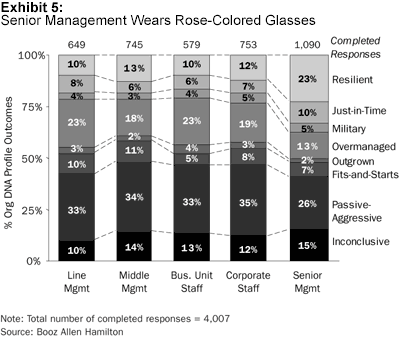
These results may indicate a disconnect between senior executives’ perceptions of the organizational structures and processes they believe they have established…and the actual adoption and utilization of those structures and processes, an observation that is certainly consistent with our experience working with many clients.
In contrast, line and mid-level managers and business unit staff tend to be pessimistic in their assessment of organizational effectiveness. Their surveys result in unhealthy profiles almost 70% of the time. Specifically, line managers and business unit staff feel overmanaged (with 23% describing behavior consistent with the Overmanaged profile), whereas mid-level and line managers believe their organizations struggle to pull in the same direction at the same time, as evidenced by the high incidence of Fits-and-Starts assessments.
Corporate staff personnel have staked the middle ground. Their responses are similar to other nonexecutives, but slightly more optimistic. Perhaps they are far enough removed from daily operations that they are less aware of organizational problems. Most notably, they do not perceive the same Overmanaged behaviors that other nonexecutives report.
Digging deeper into individual question responses, it becomes clear that senior management’s positive bias is consistent across the board. On virtually every question that tracks to the Resilient profile, senior management reported the “desirable” response more often than any other segment. Most strikingly, senior managers are far more willing to agree with the statement that “important competitive information gets to headquarters quickly” than are others in the organization. Given that disconnect and the yawning gap between their perception of their organization’s effectiveness and that of every group that reports to them, one might question how well informed these executives really are. As business operations grow increasingly complex and the pressure for greater accountability mounts, top management would do well to reassess data flows within the company and institutionalize access to timely, relevant, and accurate information.
4. Nonexecutives Feel Micromanaged
A key survey question that drew a consensus response across organizational levels was, “Managers above me in the hierarchy ‘get their hands dirty’ by getting involved in operating decisions.” More than half of all respondents answered, “Frequently,” with senior managers outreporting all other groups at 65.4%.
But survey results suggest that is where the consensus ends. Although senior managers likely view their involvement in operating decisions as good (given their overall positive bias), junior managers report feeling micromanaged. There is widespread agreement among business unit and corporate staff, as well as line managers, that “decisions are often second-guessed.” Fewer senior managers, as a percentage, see it that way.
There is also a disparity in beliefs regarding the role of corporate staff. Although business unit staff, line management, and middle management believe that “corporate staff exist to support their efforts,” corporate staff respondents believe their role is to audit line operations, a view senior management overwhelmingly supports (see The New CFO Agenda, The View From the Top, Management Spans and Layers).
These differences in perception can lead to significant organizational dysfunction. Business unit personnel may feel frustrated as they spend more time reporting up the hierarchy than doing productive work. Not surprisingly, lower-level employees report a higher incidence of “analysis paralysis” and overly bureaucratic decisionmaking in their organizations. Feeling distrusted, underestimated, and trapped in an overly politicized environment, those with initiative and exceptional talent may well defect.
5. Decision Rights Are Unclear
If lower-level employees are feeling stifled by excessive bureaucracy and layers of micromanagement, it could well be because decision rights are so poorly communicated in many organizations. More than half of the Profiler respondents indicated they felt that the accountability for decisions and actions was unclear in their organizations. This finding was consistent across all organizational levels, though senior management was slightly more sanguine (see Exhibit 6).
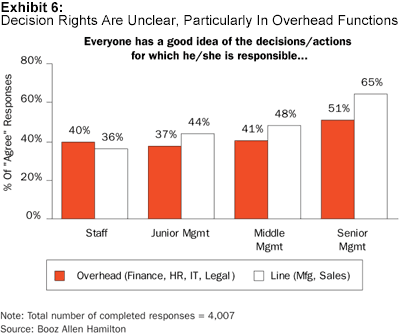
Although decision rights are remarkably vague across the board, the lack of understanding seems particularly acute within overhead functions (e.g., Human Resources (HR), Finance, Information Technology (IT)) where redundant “shadow staff” frequently multiply to fill the gaps left by incomplete or poorly specified responsibilities (see Shining the Light on Shadow Staff). Since so many overhead functions are now outsourced to third-party vendors, decision rights in those organizations may be falling victim to unclear service level agreements and governance mechanisms (see Business Process Outsourcing & Offshoring; Optimizing Internal Demand; Driving Demand Management for Internal Services).
In line organizations (e.g., Manufacturing, Sales)—except at the lowest levels—decision rights are slightly clearer, perhaps because those organizations face more direct market pressure to resolve conflicting or poorly specified responsibilities that inhibit customer responsiveness.
6. What We Have Here Is a Failure to Execute
Execution is a widespread problem that appears to worsen as companies grow. Although 37% of small company respondents (under $500 million in annual revenue) thought their organizations translated strategy into action quickly, only 29% of the respondents from the largest companies (more than $10 billion in revenues) agreed with that statement.
Respondents at all levels in companies across industries indicate that their organizations struggle to execute decisively and effectively. Less than one-third of nonexecutive respondents agree that “important strategic and operational decisions are quickly translated into action” in their organization. Even at the most senior levels, fewer than 50% of respondents indicate that their companies act decisively in implementing strategy.
Along with generally unclear decision rights, lack of timely and relevant information may also contribute to ineffective execution. A majority of respondents at all levels reports that “field/line employees frequently lack the information they need to understand the bottom-line impact of their day-to-day choices” and disagrees with the statement that “information flows freely across organizational boundaries” (see Exhibit 7). As always, senior managers as a group are slightly more upbeat in their assessments, but most still take the dim view in their responses to these questions (see The View From the Top).
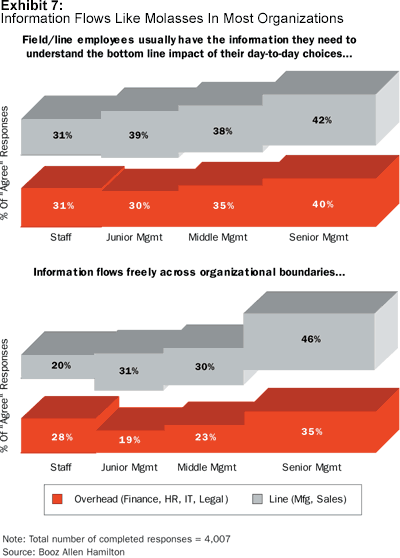
Consistent with their views on decision rights, overhead employees are also the most negative in their assessment of information flows. Although still sore points, information access and decision rights are less of a struggle for line organizations. Still, survey responses overwhelmingly point to the need for improved information, tools, and incentives for decisionmakers in all parts of the organization (see When Everyone Agrees, But Nothing Changes; Driving Demand Management for Internal Services; Attacking Overhead Costs from Both Sides).
Bio-engineering Tomorrow’s Corporation: What Booz Allen Brings
Preliminary results from the Org DNA Profiler™ assessment tool overwhelmingly confirm the hypothesis that most companies today face organizational impediments to effective execution. Whether they fall into the Passive-Aggressive profile or the Outgrown, their organizational DNA is thwarting their own best efforts…and ultimate success.
As they confront problems within their own organizations, companies are also contending with an increasingly complex global marketplace, where the only constant is continual discontinuous change. According to our early results, less than half of the Profiler respondents at all nonexecutive levels agree that their companies “deal successfully with discontinuous change in the competitive environment.” Even among senior managers, only half agree with this statement.
When an organization’s DNA is poorly configured, it exhibits unhealthy symptoms and counterproductive behaviors. The first step in fixing these problems is to identify and isolate them. That is the purpose of the Org DNA Profiler™ assessment tool. Using a framework that examines all aspects of a company’s architecture, resources, and relationships, the tool allows management to gain insight into what is and is not working deep inside a highly complex organization.
But generating a profile is not the point; it is only an exercise designed to focus managers on the root causes of their organizational disconnects and execution problems. It is up to management to translate these findings into sustainable solutions. Booz Allen can help. Our teams of experienced, cross-functional experts help senior management of large companies identify, diagnose, and remedy common organizational “roadblocks” to effective execution with an array of services and tools to facilitate one-time change initiatives, as well as longer-term transformation programs. As an example, Booz Allen offers companies the opportunity to identify and improve their organizational DNA through a facilitated one-day workshop for senior management. Using the Org DNA Profiler™ assessment tool as a starting point, top executives, business unit heads, and staff leaders (from 10 to 100 or more) come together at an offsite location to identify the impediments to effective execution in their organization and develop sustainable programs and processes to overcome them. More offsite information, including a sample agenda, is available at www.orgdna.com.
In addition, Booz Allen devotes significant attention and resources to synthesizing and presenting our best thinking on organizational effectiveness in short “white papers” or Viewpoints. Some of the most recent and relevant are outlined below.
Org DNA Readings & Tool Kit:
The Four Bases of Organizational DNA. The ability to execute is embedded in the management processes, relationships, measurements, incentives, and beliefs that constitute an organization’s DNA. Like the DNA of living organisms, the DNA of living organizations consists of four building blocks (decision rights, information, motivators, and structure), which can be realigned and adjusted to improve organizational effectiveness.
When Everyone Agrees, But Nothing Changes. From the CEO on down, senior executives continually lament the amount of time they spend wrestling with organizational problems rather than building their business. This Viewpoint explores how to align people, incentives, and knowledge to overcome organizational inertia.
Managing Customization Complexity in Service Companies Too many service companies have embraced customization in the name of growth without adapting their operating model to balance the resulting complexity costs. Consequently, companies outgrow their operating model, thereby risking their business resilience. The solution lies in adapting the “DNA” of the organization to identify, isolate, and optimize complexity.
Shining the Light on Shadow Staff. Regardless of the industry, shadow staffs lurk in the corners of most large enterprises. Once brought to light, these positions can add another 30% to 80% to total support-staff headcount. To improve operational efficiency over the long run, an organization needs to understand the reason shadow staffs exist. The organization must then eliminate that reason, but not necessarily the position. That is the surest way to eliminate duplicative and wasted effort for good.
Management Spans and Layers. If you look closely at the management ranks of many Fortune 500 corporations, all too often you will see the hourglass organization: excessive layers and narrow spans of control, particularly among mid-level directors and managers. The result is often bureaucratic buildup, bottle-necked decisionmaking, and a general lack of innovation. Organizations like these need to look beyond simple headcount reductions to find more lasting and effective methods for getting in shape.
Attacking Overhead Costs from Both Sides. Standout companies are now stepping back and adopting a new and broader perspective on the age-old cost reduction problem, one that encompasses not only traditional supply-side cost restructuring (e.g., business process reengineering (BPR), shared services, ERP, strategic outsourcing), but also demand-side optimization strategies. Approaching the cost reduction challenge from both sides has unlocked major benefits and savings for such companies.
Optimizing Internal Demand. As in the past, companies today are looking to internal services first to pare expenses. What is different is the lens they are applying; the perspective has broadened. Instead of relying solely on supply-side tactics to cut costs (e.g., BPR, automation, outsourcing, offshoring), companies are now managing the demand for internal services as well, challenging service providers and business unit customers to make serious affordability and service-level tradeoffs.
Driving Demand Management for Internal Services. The search for step-change cost reduction sets up a natural contest between line and service organizations. Business units complain that they bear the brunt of the belt-tightening and point to support services as a drain on their resources. Support functions point to benchmark studies that show they are performing at best-in-class levels and have already squeezed out potential cost savings. Can they both be right? In a word, yes.
The New CFO Agenda. According to a benchmark survey conducted by Booz Allen Hamilton, best-in-class companies are increasingly recognizing corporate officers’ roles in setting strategic direction, allocating resources, and serving as an “early warning system.” Particularly visible is the chief financial officer (CFO). More than a control agent or scorekeeper, the CFO has become an internal investment banker and the custodian of value-based performance management.
The View From the Top. Historically, many firms have relied on culture to manage the executive dialogue. As companies globalize, expand through acquisition, and diversify their operations, however, their ability to rely on tradition and shared experience diminishes. In the absence of “culture,” companies need to put in place more formal and engineered management systems, processes, and roles to keep diverse operations running smoothly and on the right path.
A New Take on Business Process Redesign. Product-focused organizations are becoming more customer-centric and learning that their current processes cannot deliver on new market requirements. Thus, once again, companies are reevaluating and redesigning their business processes—customer- and noncustomer-facing—in search of increased customer value, and internal efficiency. This new round of BPR (1) differentiates processes based on customer profitability and cost to serve; (2) occurs within the context of an overall organizational change; and (3) is built on sustainable behavior change.
Business Process Outsourcing & Offshoring. Having exploited most of the first-generation cost savings available through outsourcing, leading companies are now focusing on business model transformation. They are looking beyond IT and general and administrative (G&A) services and outsourcing processes closer to the core, including line operations, often using offshore resources. Moreover, many are exploring ways to commercialize their own world-class internal services through spin-offs and joint ventures.![]()
Author profiles:
Gary Neilson (neilson_gary@bah.com) is a senior vice president with Booz Allen Hamilton in Chicago. He works on the development of new organizational models and designs, restructuring, and the leadership of major change initiatives for Fortune 500 companies across industries.
Bruce A. Pasternack (pasternack_bruce@bah.com) is a senior vice president with Booz Allen Hamilton in San Francisco. He counsels companies in building strategic agendas, developing organizations, and transforming business models. He has published widely on leadership and organizational issues.
Decio Mendes (mendes_decio@bah.com) is a senior associate with Booz Allen Hamilton based in New York. He works with clients to improve organizational effectiveness and operations efficiency.
Eng-Ming Tan (tan_eng-ming@bah.com) is a principal with Booz Allen Hamilton in Boston. He works with companies on business model transformation programs and focuses on organizational design and effectiveness.


